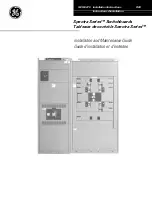
1 0.2.1 REPLACEM ENT O F CU RRENT
SENSORS
Referring to Fig. 63, replacement of i ndividual SST
current sensors is accomp l ished as follows:
a) Disconnect the breaker harness from the tap ter
minal board, removing cable ties as necessary. Un·
fasten the termi nal board from the breaker base.
b) At the rear of the breaker, remove the two Allen
head screws to separate the stud connector from the
contact pivot block.
c) Loosen the clamping bolt and remove the stud
connector. Lift out the sensor and It� tap terminal
board.
The sensor may be prevented from slipping off the
sensor stud by adjacent accessories. If this exists,
the sensor stud must be removed from the breaker
base. The stud assembly is secured to the base with
four bolts which are accessible from the rear of the
breaker.
d) When rep lacing the stud connector, tighten the
Allen head screws to 250
±
10 in·lbs. Tighten th6
clamping bolt as follows:
AKA 30/30H - 1 20
±
10 i n·lbs
AKA 50/50H - 470
±
1 0 in·lbs
AKRT 50/50H - 470
±
1 0 i n·lbs
1 0.3
FLUX S H I FT TRIP DEVICE
The Flux Shift Trip device is a low-energy, elec·
tromagnetic device which, upon receipt of a trip
signal from the programmer unit, trips the breaker by
actuating the trip shaft.
The mounting arrangement of this component is II·
l ustrated in Figs. 64 and 65. An electromagnetic ac·
tuator located on the underside of the front frame i s
coupled t o the breaker's trip shaft via a trip rod driven
by the actuator arm. The actuator is a solenoid whose
armature is spring-loaded and held in its normal
(Reset) position by a permanent magnet. In this state
the spring is compressed.
1 .
Flux shift Trip Device
5.
Tap Terminal B>ard
48
2.
A llen-head Screws
6.
Progr ammer Unit
3.
Stud Connector
7.
Clamp Bolt
4.
Current Sensor
8.
Sensor Stud
FIG.
63
-
AKR-SA-30 BREAKER WITH SST TRIP DEVICE
www
. ElectricalPartManuals
. com
















































